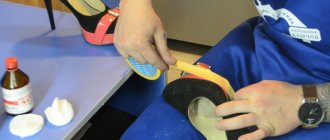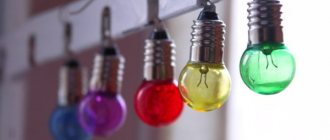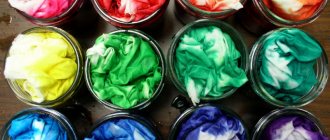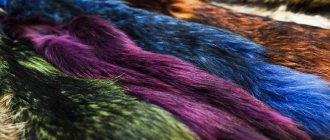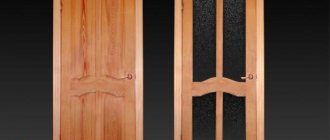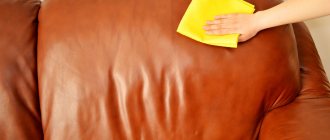How to paint leatherette at home
The result of painting leatherette at home largely depends on the products used for this. The work can be done using different materials.
Bottles with shoe impregnation
If you only need to slightly restore certain places on a bag or jacket, you can use products designed for shoes. Small bottles of shoe impregnation are quite convenient. A sponge attached to the bottle, soaking in its contents, reliably paints problem areas. If there is no such sponge on the bottle, you can use a brush or make a tampon for impregnation yourself.
Important! Painting leatherette with shoe impregnation will be of better quality and durability when applied in 2 layers, with a 30-minute break for absorption.
Special paints for artificial leather
Designed to renew the skin, such paints penetrate deeply into the structure and provide reliable coloring of the material.
At the same time, things become protected from moisture and retain the ability to pass air. They are convenient in aerosol packaging, as well as when using a spray gun, sponge or brush.
Acrylic paints
Acrylic paints provide good results not only for restoring individual abrasions, but also for completely repainting leatherette items. They are interesting not only for their varied colors, but also for their qualities.
Acrylic is a flexible material that can stretch. Thanks to this, paints protect things from cracking. To work you will need a brush or sponge.
Important! When the paint thickens, you can return it to the required consistency using acetone. You need to add 2-3 drops to it and mix thoroughly.
Spray painting
This is the fastest way. It is best to carry out the operation outdoors or in a garage, since dye splashes can get on interior items.
The spray painting procedure looks like this:
- The container is shaken several times.
- The paint is applied in a thin layer, with uniform and quick movements, to the product from a distance of 25–30 cm.
- The remaining substance is removed from the jacket using a sponge.
- The item is dried.
- If there are poorly painted areas, the procedure is repeated.
Choosing paint for leatherette
Buying a product for coloring artificial leather is easy. This can be done at different retail outlets.
Hardware stores
In hardware stores you can purchase professional paints intended for artificial leather, as well as acrylic dyes.
Handicraft stores
Products in small packages can be found in craft stores. They offer a variety of colors of acrylic paints, small containers with special dyes for natural and artificial leather. Handicraft salons also offer chalk paints. They will be of interest to those who want not only to paint the upholstery of leatherette furniture, but also to make it stylish, specially giving it an aged look.
Shoe stores
In stores or departments that sell shoes, you can choose an impregnation for shoes, which is also suitable for updating other leatherette items.
All these products will ensure high-quality painting of artificial leather.
Types of paints for automotive leather
Products for painting leather car interiors can be found at a parts store or ordered online. There are regular paints for coloring leather and professional formulations. Each remedy has its pros and cons.
Acrylic
There are special acrylic paints for leather. These products should not be confused with repair compounds. The label for acrylic paints should say “for leather”. Such products are used to tint any leather products, including car interiors.
Source
Preparing things for painting
The material must be cleaned before painting.
If there is a layer (even invisible to the eye) of dust and dirt between the surface of the item and the dye, the layers of paint will move away from the material and cracks will appear. The procedure for preparing leatherette for painting:
- Cleaning. To clean artificial leather, you need to treat it with a soapy solution and then rinse thoroughly with clean water. Perform the work with a cotton napkin or sponge.
- Degreasing. Using a swab or sponge soaked in an alcohol solution, wipe the item again, removing any remaining dirt.
Important! After cleaning, work with artificial leather only with gloves, so as not to leave traces of stains on the cleaned surface; they may appear during dyeing.
- Drying. Before painting, make sure that the leatherette is completely dry.
Important! Allow items to dry naturally, without using heating devices or heaters, which may cause deformation of the material.
How to paint metal doors
Painting metal doors is fundamentally different from painting wooden doors.
How to paint a metal door
The metal surface is cleaned, wiped and dried. At the same time, rust and old coating are removed, and uneven surfaces are primed. Paint for metal doors can be alkyd, graphite, acrylic, hammer, epoxy. It is applied in several layers, after which it is allowed to dry completely.
How to paint a scratched door with spray paint
The damaged area is sanded to prevent rust. Then the area is wiped with solvent. Next, the metal doors are painted with powder paint in several layers, and the first layer can be made with primer.
Paint a bag or suitcase
Have you been wanting to update your bag or suitcase?
Don't delay, but start making your desires come true! Prepare the necessary materials:
- Paint (we recommend using acrylic).
- Acetone for dilution.
- Items for applying dye (brush, sponge).
- Items for working with paint (palette).
- Gloves for work.
Advice! If you don't have a special palette (or a palette from a children's painting kit), you can replace it with regular aluminum baking foil.
Carefully read the instructions for painting leatherette items. Doing the job according to these tips will help you get a good result.
- Prepare the bag for painting by thoroughly cleaning and drying its surface.
- Prepare the paint. Apply some paint to the palette or foil. It shouldn't be thick. To dilute, use acetone.
Important! Please note that acrylic dries quickly. Do not squeeze a large amount of paint onto the palette at once; it is better to add it as needed.
- Mix the squeezed out paint with a brush or sponge.
- Start painting. Try to apply the dye evenly, in long strokes.
- Once completely dyed, leave the bag to dry. This will take 15 to 20 minutes.
- Apply 2nd coat. If you are not completely satisfied with the result, after the 2nd layer has dried, you can paint it again.
- Let the bag dry on its own; do not place it near heating appliances.
Eco-leather painting (leatherette)
The soft corner is half covered (sides and bottom) with eco-leather (leatherette, leatherette or something like that) and feels soft and pleasant to the touch. After a year, it began to slowly peel off.
Reupholstery costs more than a new corner. Please advise if it can be painted and with what? You can paint it, but it will still be noticeable. It’s not leather, it’s crap. Cover with anything.
Spray cans for painting leather and substitutes are sold in shoe stores, for example. But I’m not sure that this is a good option, it will still be clear that the dermantine is shabby; judging by the photo, it’s not just the paint that has peeled off, but the top layer of the coating itself.
Painting is really useless, since the top layer of plastic peels off from the fabric base, and this will only intensify over time until complete baldness. This is now a common thing, manufacturers use the cheapest Chinese leatherette for 150 rubles, so new furniture costs less than reupholstery with high-quality material. Throw away this one, buy a new one - it will have the same cheap leatherette. To paraphrase a well-known saying about one’s own and others’ army, one can say: if you don’t want to feed the re-upholsterers, you will feed the manufacturers of budget furniture.
wal73 wrote: if you don’t want to feed reupholsterers, you’ll feed budget furniture manufacturers
But the “reupholsterers” (what a word) all use only high-quality material.
wal73, About 30-35 years ago, leatherette served a lot longer. Now - artificial leather, vinyl leather, eco-leather (from what?), where is the progress? Already ECOSPON. What kind of damn wood?! I.E. from which something doesn’t grow? The list can go on for a very long time. Let’s do it for 1 year, and no grass will grow there! PS-PS. The design is good, the mechanism is 5, so what is all this done for? YAAAAAA. To curb unemployment a little. But! I am UNEMPLOYED and disabled, not armless. I make the furniture myself, BUT. It’s cheaper for me to buy it than to buy just the materials. Where the hell is justice? Again: PS -Sorry for the pun, it’s boiling.
alek-shakh wrote: I make the furniture myself, BUT. It’s cheaper for me to buy it than to buy just the materials!
So what's the problem with re-upholstering? This is probably better than repainting someone who is bald. And next time, don’t fall for IVF temptations.
You can ask the question at auto repair shops where they actively do painting. They will probably first of all advise you to try silicone spray.
alek-shakh wrote: I make the furniture myself, BUT. It’s cheaper for me to buy it than to buy just the materials!
So what's the problem with re-upholstering? This is probably better than repainting someone who is bald. And next time, don’t fall for IVF temptations.
I repeat: It’s cheaper for me to buy it than to buy only the materials.
alek-shakh wrote: The design is good, the mechanism is 5, so what is all this done for?
Be grateful that the manufacturers saved only on leatherette. There is no such thing as budget furniture without savings. I repeat once again that if you get rid of this sofa and buy another cheaper one, it may have a bad design and a poor mechanism, and the material is unlikely to be better. Upholstery is just like clothing; it can be changed several times if the sofa itself structurally deserves it.
alek-shakh wrote: I repeat: It’s cheaper for me to buy it than to buy only the materials.
How is that? Are several meters of material (approximately 3 meters for two armrests plus a little for the bottom of the sofa) more expensive than a whole corner sofa? Maybe you have your sights set on elite leathers?
If you can't get normal leatherette, consider faux suede. In terms of practicality, it is close to leatherette, but even cheap varieties do not crack (however, over time they become greasy from hands, but many varieties of suede can be refreshed with a damp cloth).
Tips for painting leatherette items
- Pay attention to the specific type of faux leather the items you want to paint are made from. Get acquainted with the features of caring for this type of material.
- Carefully read the instructions for use of the selected dye and strictly follow its instructions.
- Do some preliminary testing before painting. Select a small part of the leatherette and test the dye on it. This will ensure that the material does not experience any unwanted reactions when interacting with the dye. Allow the painted area to dry completely to see the final color.
Eco-leather painting (leatherette)
The soft corner is half covered (sides and bottom) with eco-leather (leatherette, leatherette or something like that) and feels soft and pleasant to the touch. After a year, it began to slowly peel off. Reupholstery costs more than a new corner. Please advise if it can be painted and with what?
You can paint it, but it will still be noticeable. It’s not leather, it’s crap. Cover with anything.
Spray cans for painting leather and substitutes are sold in shoe stores, for example. But I’m not sure that this is a good option, it will still be clear that the dermantine is shabby; judging by the photo, it’s not just the paint that has peeled off, but the top layer of the coating itself.
Painting is really useless, since the top layer of plastic peels off from the fabric base, and this will only intensify over time until complete baldness. This is now a common thing, manufacturers use the cheapest Chinese leatherette for 150 rubles, so new furniture costs less than reupholstery with high-quality material. Throw away this one, buy a new one - it will have the same cheap leatherette. To paraphrase a well-known saying about one’s own and others’ army, one can say: if you don’t want to feed the re-upholsterers, you will feed the manufacturers of budget furniture.
wal73 wrote: if you don’t want to feed reupholsterers, you’ll feed budget furniture manufacturers
But the “reupholsterers” (what a word) all use only high-quality material.
wal73, About 30-35 years ago, leatherette served a lot longer. Now - artificial leather, vinyl leather, eco-leather (from what?), where is the progress? Already ECOSPON. What kind of damn wood?! I.E. from which something doesn’t grow? The list can go on for a very long time. Let’s do it for 1 year, and no grass will grow there! PS-PS. The design is good, the mechanism is 5, so what is all this done for? YAAAAAA. To curb unemployment a little. But! I am UNEMPLOYED and disabled, not armless. I make the furniture myself, BUT. It’s cheaper for me to buy it than to buy just the materials. Where the hell is justice? Again: PS -Sorry for the pun, it’s boiling.
alek-shakh wrote: I make the furniture myself, BUT. It’s cheaper for me to buy it than to buy just the materials!
So what's the problem with re-upholstering? This is probably better than repainting someone who is bald. And next time, don’t fall for IVF temptations.
How to care for dyed items
To ensure that the appearance of a painted item brings pleasure for a long time, you need to follow simple rules for caring for painted leatherette.
Timely cleaning
All contaminants should be removed from the painted material, not leaving even minimal ones unattended. For cleaning, use a damp cloth or sponge. You can use a soap solution, which is then thoroughly washed off with clean water.
Drying
Wet faux leather items need to be dried thoroughly. For this purpose, items of clothing are hung on hangers and given shape. Shoes can be stuffed with old newspapers. The bag is emptied of things, hung and shaped, for which you can also use paper.
Leatherette things will continue to delight you! You have already appreciated their practicality. And with the help of our article, you can paint artificial leather to restore the attractive appearance of your favorite bag, jacket or comfortable shoes!
Source
How to paint
For painting
product, you must first prepare the room, equipment and the jacket itself:
- Make sure that the room is well ventilated, lay down oilcloth or film.
- Clean the jacket itself from dirt: wipe the product with a soft sponge soaked in a soap-based solution, then rinse with warm water.
- Check the item for grease stains that could lead to uneven coloring. If there are any, remove them with a cotton pad or sponge soaked in ammonia or purified gasoline.
- Dry the leather product.
- Treat the surface with a regular sponge or cloth soaked in alcohol.
- Hang the jacket on hangers, place it on a mannequin or prepared surface, fasten it so that the paint does not get inside, straighten out the folds.
Types of paints for leatherette
The principle of operation of paint for artificial leather is that its pigments penetrate into the deep layers of the material and are fixed in the fibers, creating a durable and breathable coating that protects it from moisture.
Acrylic based paint
The product is effective for removing small defects, abrasions and for complete restoration of leatherette. The properties of acrylic paint are optimal and it copes with its function perfectly. The color palette is quite diverse, from white to black, metallic, with a pearlescent tint. Using more expensive acrylic paint, you can achieve a decorative effect, for example, create a matte or textured finish. Dye with acrylic is used to apply a design or pattern to leatherette. Acrylic is a very flexible and durable material. Thanks to this, the dye does not crack after application, does not fade in the sun, is not subject to mechanical damage and creates a durable, protective film on the skin. The composition is used for both smooth and textured synthetic leather. To paint leatherette with acrylic paint, you will need a brush or foam sponge.
Cream paint for leatherette
You can use cream paint to paint furniture, bags, clothes and shoes. It is sold in a tube and is a paste-like mass that is applied to the surface with a sponge or cotton swab.
Aerosol paint
Aerosol is more convenient to use than other types of dye. Paint for leatherette in a can is contained in liquid form. It is absorbed into the surface better and penetrates into the deepest layers of leatherette. The product is used very sparingly, as it is sprayed onto the surface in a thin layer. Due to this, the drying time of the composition is also reduced. To create a more durable coating of rich color on the surface of the leatherette, the product is applied in two to three layers. The aerosol is most often used for professional painting of leather surfaces, such as car interiors, but this does not mean that it cannot be used for painting leather at home.
Possible defects in leather interior
If the car interior is upholstered in leather, then over time, due to frequent touches or mechanical damage, various defects appear on the surface. It is impossible to keep the leather parts of a car in its original condition. After all, active use of a personal car leads to wear and tear on those parts of the interior (seats, steering wheel) with which the driver or passengers often come into contact.
Leather interior defects that can be painted over:
Paints with a polymer composition can not only paint over the skin, but also smooth out defects. The main thing is not to skimp on the means for painting a leather product. Staining is recommended to be done according to the manufacturer's instructions.
How to paint leatherette correctly
There are rules to achieve a satisfactory coloring result.
Surface cleaning
Before painting leatherette, it is necessary to first prepare it, namely, remove dirt and degrease. A weak solution of laundry soap is suitable for cleaning the surface, and ethyl alcohol for degreasing. Remember that dirt and dust can cause paint to peel off after drying. After degreasing, try not to touch the skin to avoid the appearance of fresh grease marks from your fingers.
Testing
Be sure to check the suitability of the dye for the leatherette that is being processed. To do this, apply a small amount of the product to an inconspicuous area of skin and monitor the reaction. This way you can make sure that the color of the dye matches the color of the product. When choosing paint, you should also take into account the fact that after drying it will become lighter.
Drying the product
In order to be satisfied with the coloring result, you should not rush while doing the work. After cleaning the surface from dirt and degreasing, the product must dry thoroughly. Faux leather should also dry well between stages of dyeing, that is, after each applied layer of paint. The dyeing procedure is also completed by drying the product at room temperature. The dyeing process must be carried out strictly in a ventilated room.
Application of liquid paint
To restore a jacket using liquid dye you need:
- Shake the bottle and pour its contents into the prepared container.
- Spread the jacket on a flat surface covered with film, smooth out the folds.
- Dip a sponge or woolen cloth into the product, squeeze lightly, and begin staining. Movements must be blotting and circular. You should beware of excess paint, apply it in a thin layer.
- After drying the product, apply another layer of dye.
- Dry the item.
HOW TO REMOVE A STAIN ON LIGHT SKIN?
Instructions for dyeing synthetic leather
To work, you will need paint, a solvent, a tool for applying the composition - a sponge or a brush, personal protective equipment - gloves, a respirator. Carefully study the manufacturer's recommendations for paint use indicated on the packaging.
- Before painting a synthetic leather product, it is necessary to clean the surface, degrease it and dry it under natural conditions.
- Prepare the paint. Acrylic and cream dye can be diluted with 2-3 milliliters of solvent to achieve a more liquid consistency.
- Gently mix the composition with a brush.
- The next step is painting. The product must be applied evenly, in a thin layer.
- When the skin is completely covered with paint, you need to dry it for half an hour.
- Then the dye is applied to the skin in another layer. If after drying the result is unsatisfactory, then you can paint the artificial leather a third time.
- After applying the final layer, the material must be dried away from heating radiators.
How to upholster a door with dermantine with your own hands: Features of the material and Decoration + Video
In addition to its protective function, the front door serves as a decoration and addition to the interior of the house. Even an old door can be transformed with new upholstery, for example, dermantine. It’s quite easy to do even on your own, and the material is quite affordable. How to upholster a door with dermantine with your own hands is described in this article. Dermantin is translated as imitation leather. This material is based on nitrocellulose-coated cotton fabric. Today it is the most common upholstery material, which has the following advantages.
In what cases can you dye a leather product at home?
Should you restore a leather product yourself or send it to a workshop? This question may arise when you see a worn leather jacket, bag or shoes. Before you take on coloring at home, you should weigh the pros and cons and try to objectively assess your own capabilities.
In what cases is it advisable to paint houses:
- the area of damage is small, so there is no point in paying for expensive workshop services;
- the owner of the product has experience in painting leather products;
- the item is valuable, expensive, and there are no dry cleaners or workshops nearby that you could trust with the work.
Advantages of painting over reupholstering the car interior
The interior of an expensive car is usually covered with genuine leather. In cheaper cars, the steering wheel, front panel, and gear shift knob may be leather. Over time, due to frequent touching, scratches, abrasions and other defects appear on the skin. There are two ways out of this situation. You can order reupholstery of the entire interior or individual parts of the car in the workshop. This will take at least 2 weeks. It’s easier, of course, to restore leather elements, that is, to tint them.
Advantages of the method of painting interior leather yourself:
Painting a leather interior yourself is an affordable, low-cost and attractive solution to the problem. You can restore the appearance of leather products even without experience in performing such work. The restoration will only take a few hours. The main thing is to buy a high-quality composition.
It’s better not to skimp on painting products. Cheap paint is less durable, wears off quickly, and gets your hands dirty. It is advisable to buy professional products.
Such compositions not only paint the leather surface, but also smooth out defects and fill scratches and cracks.
When is it better to stop dyeing leather items yourself?
You should turn to the services of a workshop if the owner of the product does not have the necessary skills and is afraid of ruining the thing. You need to choose an organization carefully, read reviews in advance, ask what dyes are used in the work, and what responsibility the craftsmen bear for the entrusted item.
It is also recommended to leave the material in the hands of professionals when the area to be painted is large. For example, if you need to change the color of a jacket or bag to black, brown, white.
How to make door trim yourself using dermantine
The door is important not only to restrict entry into the home for strangers. Over time, its aesthetic function became no less important. The door has been in the apartment for many years. Over time, her appearance worsens. However, it is not necessary to perform a replacement. If the doors are upholstered with dermantine, they will take on a new look.
What to look for when choosing a door trim kit
Dermantin is used for door upholstery. The name of this fabric translates as “material that can replace leather.” The basis of this fabric is cotton fabric, which has a nitrocellulose coating. It can be either on both sides of the material, or only on one.
entrance to the house
This leatherette has important features due to which it is used for upholstery:
- It is important that such matter has a long service life.
- During the entire period of operation, dermantine retains a respectable appearance.
- It is moisture resistant. The fact that it does not absorb moisture contributes to its strength and durability.
- This material is not vulnerable to rotting, fading from sunlight, or temperature changes. Doors covered with dermantine will not change their appearance even if they are located outdoors.
- It can be cleaned using specialized household products.
Note! A door upholstered with this material will last at least ten years.
Samples of dermantine upholstery
In addition to dermantine, the following can be used for this purpose: PVC film, vinyl or genuine leather. However, the material in question combines affordable price, high quality and durability in the best possible way.
Foam rubber is the best option for a budget insulation layer. For upholstery, a layer 1-2 centimeters thick is enough. You can use felt for this purpose.
If you need glue, you can take “Moment” for this purpose. No more than 100 milliliters will be required for one side of the door leaf.
Tools and consumables
In order to make door trim with your own hands, you need to prepare the necessary tools and materials. Before doing this, it is important to measure the area.
Upholstered door
If we are talking about the design of wooden doors, then the area of the fabric for upholstery corresponds to the size of the door. An additional 15 centimeters will be required on each side. For metal doors, in addition to the area equal to their surface, an additional 10 centimeters of dermantine will be required.
When working, you will need rollers. They should be located along the edges of the door and are designed to close gaps that may form when closing.
The choice of insulation is important. If the service life of the product is longer than the service life of the insulation, it may rot. What follows is a short overview of the options.
Upholstery example
Important! Foam rubber is often used for this purpose. Its permissible service life is 13-15 years. For batting, this period can reach up to 30 years. However, it is more expensive than foam rubber and has more weight.
Isolontape is a modern material used for this purpose. Its service life is 60-75 years. Its combined use with foam rubber cannot be ruled out.
Superficial and deep staining: description of methods, pros and cons
There are two methods of staining: superficial and deep. As the name implies, when surface painting, only the front side is painted. To do this, use brushes, rollers, tampons, and sponges. Stages of work:
- The product is laid out on a flat surface and smoothed;
- the paint is diluted in a separate container and applied to the front side using a brush or roller;
- the item is left to dry away from open sources of fire and direct sunlight;
- after 5–6 hours, knead the product with your hands to prevent it from hardening and becoming rough;
- Finally, they are covered with a fixing agent - cream, silicone grease.
The advantage of this method is its simplicity and accessibility. It is easy to use at home. Surface painting is well suited for small items - handbags, shoes, wallets. This way you can also paint large objects: sofas, armchairs. Unfortunately, uneven coloring is possible due to different intensity of strokes. Without proper experience, it is difficult to apply even strokes to the surface of a leather product.
Deep dyeing involves completely immersing the item in paint. Algorithm of actions:
- the paint is diluted in a basin, pan or bucket according to the instructions;
- the mixture is brought to a boil on the stove, then cooled to 45°C;
- the product, previously moistened with water, is lowered into the container so that it is completely immersed in the paint;
- periodically turn it for uniform staining;
- after a few hours, as indicated in the instructions for the paint, the skin is taken out and rinsed several times, first in warm, then in cold water;
- The skin is covered with a fixative and left to dry.
Deep dyeing is convenient for dyeing whole cuts of leather and faux leather before sewing or bulky items (raincoats, coats). You shouldn't paint your shoes this way. It is not entirely convenient to use this method at home - not everyone has such a large container to immerse the entire thing, and when boiling, the paint emits a rather unpleasant odor.
Dermantine or vinyl leather
Door upholstery with dermantin (leatherette) is one of the most economical options; batting serves as the insulation base. A modern option is vinyl leatherette upholstery (durable fabric coated with polyvinyl chloride), with foam rubber used as insulation. It is used for upholstery and lining of entrance doors of a wide variety of rooms.
- Frost resistance
- Abrasion resistance
- Fire resistance (the material does not burn, but smolders)
- Withstands temperature changes, humidity, exposure to sunlight
- In combination with insulation, it provides excellent noise and sound insulation.
Compared to dermantine, vinyl artificial leather is a more environmentally friendly material, has better frost resistance, and a richer selection of colors and patterns.
Review of popular skin coloring products (composition, method of application)
There are many means to change the color of natural or artificial leather: acrylic and powder paints, creams, aerosols. Each of these types of dyes has its own advantages and disadvantages, based on which you should choose the most suitable composition for painting.
Acrylic paints for leather and leatherette
Acrylic paints are made on a water basis with the addition of polyacrylates. They are safe, non-toxic, do not emit harmful substances when dried and do not have an unpleasant odor, unlike many other dyes.
The main advantage of acrylic paints is the coating they create on the material. In addition to painting in standard colors from white to black, you can achieve a matte surface, liquid skin effect, and pearlescent tints.
Benefits of painting leather parts
Sewing new covers for car seats, as well as reupholstering them, will cost a significant amount. But there is a technology that allows for high-quality restoration of seats and other elements - painting. This will be the best solution for those who want to carry out partial repairs. The material for painting is selected strictly to match the skin tone, so the areas where paint is applied will not be visually noticeable. It is also possible to completely renew the casing, ensuring high quality repairs.
There are a number of other advantages of using paint for leather interiors:
Dyeing leather products using improvised means
You can paint your skin without using special paints, using only available means:
- Vinegar and rusty nails. About 40 large rusty nails are placed in 2 liters of vinegar and left for 15 days. The nails are first degreased with alcohol. After 2 weeks, the smell of vinegar disappears - this indicates that the composition is ready. It is filtered several times and a thing soaked in water is dipped into it. Separately prepare a soda solution - 3 tsp per 1 liter of water. soda The product is washed under running cool water and dipped in a soda solution. To secure it, Vaseline is applied on top, after which the item becomes dark in color.
- Tea. Add 30 black tea bags to 4 liters of water and boil for 3 hours. Then add water to the original volume and immerse the leather item. To ensure that the color is rich and lasting, the skin is kept in tea leaves for 2 days. To get a burgundy color, use hibiscus tea.
- Berry juices. The skin should only be immersed in freshly squeezed natural juice. To dye, you need to keep the product in it for at least 36 hours. Raspberry juice gives a red tint, lingonberry - scarlet, blackberry - lilac, blueberry - blue.
Using polymer paint
This option allows you to paint the entire product equally, touching small details and hard-to-reach places: seams, armpits, area under the collar, pockets. You should follow the instructions:
- Prepare the product: following the instructions, dilute the powder with warm water, boil the mixture, keep on fire and stir until small particles dissolve.
- Cool the solution to 40 degrees, place the jacket in it.
- Keep the product in the composition for about 2 hours (until it reaches the desired shade), turning the item over every 30 minutes.
- Rinse the dyed jacket in warm drinking water until the water flowing from the item becomes clear.
- Dry the product by spreading it on a hanger.
Tip: Before powder painting, it is recommended to soak the jacket in drinking water for 2 hours to allow air to escape from the pores of the leather. The paint will lie more evenly.
Finishing the item with a fixative
There are ready-made finishing compositions - dressings. They are usually water or alcohol based and contain a polymer, wax or resin to provide a film coating. Some finishes impart a matte or glossy finish. After finishing, the leather is polished with a soft cloth.
You can also fix the paint using improvised means. To do this, add 200 ml of table vinegar and 1 tablespoon of soda to 1 liter of water and bring to a boil. The item is soaked in this liquid and then lubricated with Vaseline, castor or olive oil.
How to paint eco-leather
Ecological leather material is practical. It makes excellent products that need to combine the quality of real leather with the durability and wear resistance characteristic of artificial material. The quality of eco-leather depends on the production technology. And also from the correct painting.
Silicone spray
Silicone spray makes it possible not only to apply the same layer of paint, but also forms a protective film on the surface. It adds very high resistance to things and at the same time has a coloring effect. There are silicone coating materials that only provide the opportunity to protect the eco-leather coating. These products are colorless, but at the same time they can refresh the appearance of an eco-leather product, give a little shine and increase wear resistance.
Silicone is an excellent material that gives the surface a glossy finish.
Paint for eco-leather in a can
Thanks to the dyes in the can, painting an eco-leather item, even a large surface, has become simple and easy. Spraying the spray allows you to apply color pigments evenly to the product. Spray painting is best used if the surface of the product is large, for example, a sofa made of eco-leather. The spray allows you to paint even hard-to-reach places. It is good to use the spray on medium-sized products. Especially if you need to paint quickly.
It is enough to buy a can, shake it and spray evenly at a certain distance. In most cases, the surface must be degreased in advance.
Aniline dyes
In most cases, aniline dye has a concentrated structure. While working with it, re-application will often not be required.
Some paints require dilution with water.
A minimal amount of product and a sponge are enough; with it you can saturate the surface of an eco-leather product. Aniline dyes are harmless. When used correctly, the effectiveness of paint coating
Using such a product is very economical, since a large surface of eco-leather will require a minimal amount of paint.
Vegetable dyes
To paint with vegetable dyes, you first need to determine what color intensity and tone you want to achieve. If a shade of brown with red is required, then extracts of mahogany wood species, a solution based on saffron and alcohol are suitable. Alder bark produces a rich brown and orange color. And larch bark tincture adds an ocher-tinged color to the product, while maintaining the key tone brown.
Possible problems and ways to prevent and eliminate them
Beginners may have problems with skin coloring:
- After drying, the color becomes lighter than when painted. To avoid the result not matching the desired shade, it is recommended to first paint a small area of the material and only then proceed with full painting.
- If uneven strokes are visible on the skin, it means that the staining technology was violated. The first layer is applied with vertical strokes, the second with horizontal strokes, and the third with circular strokes.
- To prevent the surface of the leather from cracking and the item from losing its proper appearance, do not dry the painted item near a radiator, in the sun or near a fire.
- If you overexpose your skin to paint or dry it incorrectly, it becomes hard and loses its elasticity. You can soften the surface using castor oil.
Do-it-yourself painting requires certain skills. It is advisable not to try your hand at expensive, valuable things, but to start by painting an old wallet or a worn-out handbag and only then start changing the color of jackets, raincoats, and furniture upholstery.
Source
Installing fittings and doors into place
After you finish attaching the decorative parts with your own hands, place the door vertically and move away a few meters. This way, irregularities and distortions in the drawing will be better visible. If everything is in perfect order and you are satisfied with the result, proceed to installing the door hardware in its place. It is better to start with the peephole, since it is located almost in the center of the door. Then attach the lock and handles.
When the door is completely ready, you can hang it in its place and check for smooth movement and tightness. By following these simple instructions, you can perform a wide variety of door upholstery options with dermantine. Let's look at a few more nuances that you should know for various design features.
How to paint vinyl leather
Our experienced team of editors and experimentalists contributed to the development of this article and reviewed it for accuracy and completeness. Number of sources used in this publication: 12. You can find a list of them at the bottom of the page. wikiHow's content management team closely monitors the work of its editors to ensure that every article meets our high quality standards. Leatherette is widely used for furniture upholstery, tailoring and making accessories. In most cases, it is made from plastic polymer materials so that it looks and feels like real leather.
Painting vinyl leatherette is a very interesting and cheap way to “revive” an old, worn item.
Just find the right paint that will stick to vinyl leather and have fun painting an old chair or adding your own personal design to a vinyl leather handbag or skirt!
Selection of paint for the material
The paint for doors is selected based on the material from which they are made. For example, it is almost impossible to paint MDF surfaces with stain. Therefore, the appearance of the interior door panels will depend on the choice.
Natural wood
Perhaps the most common and desired material for the manufacture of any door systems. The texture of natural wood creates an excellent visual effect.
For wood, you can choose varnishes or stains. This will highlight the characteristics of the material, and highlight the wood-fiber textured look.
Even wood simply opened with colorless varnish will have an excellent appearance and will serve for a long time.
Any type is suitable for wooden surfaces. But for doors in bathrooms and bathrooms it is better to give preference to more water-resistant alkyd enamel.
